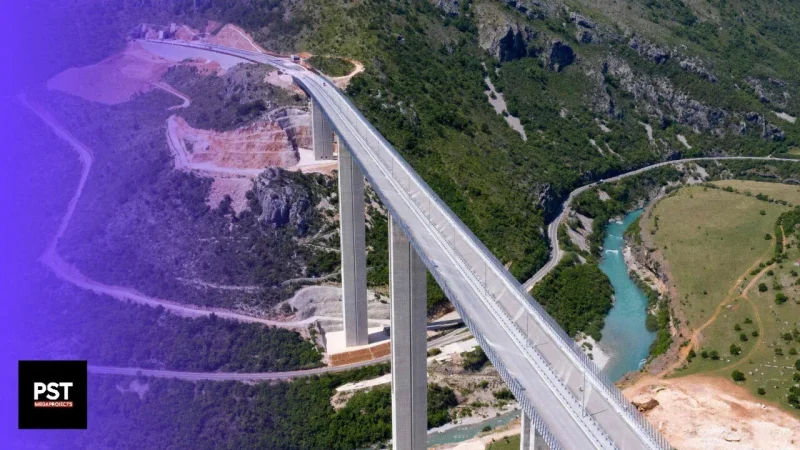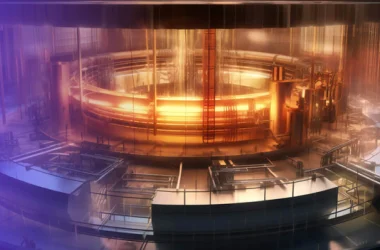If you’ve never heard of Montenegro before, we don’t blame you. It’s one of the smallest countries in Europe, known for its rugged mountains, pristine forests, and very tiny population of around 620,000 people.
It’s also one of the continent’s poorest countries, with a GDP of around $6 billion. But, despite this, Montenegro has been home to one of the world’s most expensive highways in the entire world since 2022.
The A1 Highway in Montenegro is a Chinese-built road that allows drivers to effortlessly cross the country, offering them a stunning view of Montenegro’s landscape at the same time. But, it came with a massive price tag. As it was financed by a $1 billion loan from China, leaving the small European country balancing on a tightrope of debt, with bankruptcy looming on the horizon.
The A1 Highway
Montenegro is known for its harsh and mountainous landscape, and that meant that building a straight highway surrounded by these conditions was truly miraculous, as well as very expensive. While having a smaller population means that people in Montenegro are richer per capita than bigger economies in countries like Albania, it’s still not a country that could afford to invest heavily in large infrastructure projects.
This might be why the project was so controversial, especially since it’s considered Montenegro’s most expensive project ever. But, if we’re being honest, this hefty price tag was to be expected due to how hard construction was.
Thanks to Montenegro’s mountainous terrain, the construction team working on this highway were forced to build a collection of 20 bridges and 16 tunnels through thick rocks, rather than a typical highway. In fact, only 40% of this project was made up of what you might call regular roads.
Despite the project’s high cost, the country’s former president, Milo Đukanović, was extremely excited about the project and the advantages it would eventually bring. One of these advantages is connecting Montenegro’s port city of Bar to the Serbian capital of Belgrade, turning the small Balkan country into an important transport hub in Europe.
In addition to that, the highway’s route across the north of Montenegro was expected to equalize the economy by spreading the wealth of the coastal south to the poor and mountainous north, and encouraging the millions of tourists that visit Montenegro’s beaches each year to explore its other side.
For example, let’s take a closer look at the village of Matesevo, which is only 41 kilometers away from the capital, but it has long been disconnected from it. In fact, any Matesevo locals that wanted to travel to the capital have been forced to take a 180 kilometers detour along twisting and dangerous roads. But, now with the new highway, they could take the same trip but much safer drive and under 25 minutes.
The Project Remains Incomplete
So far so good for Montenegro, but the highway still faces one major problem: it ends in Matesevo, and doesn’t connect to the Serbian capital like it was planned to. The $1 billion in funds wasn’t used to complete the full length of the 163 kilometers highway, but just a little bit over a quarter of the proposed route; a 41-kilometer road that now ended in a village with a population of less than 100 people.
In addition to that, most of the people living in the village are so poor that they can’t afford the highway’s $3.7 toll. Technically, Montenegro spent one-sixth of its GDP and ended up with a road to nowhere.
The first phase of the project opened in 2021, and now three years later, the megaproject remains unfinished and many kilometers short of Serbia. Naturally, this led people to wonder if the remaining 122 kilometers will ever be completed.
The Origins of the Project
The story of this failed highway goes back to 2005, when Montenegro wasn’t even a separate country, but part of the State Union of Serbia and Montenegro, which was the last piece remaining of a Yugoslavia that has already lost so much of its territory in a succession of wars. The idea of somehow connecting the port city of Bar to the Serbian capital was proposed back then by the former president Đukanović, as a way to keep the two countries together.
But, that ended up coming to nothing, because a year later in 2006, Đukanović led his country to independence, and yet, he still refused to abandon the idea of a connection between Montenegro and Serbia.
In fact, in 2007, he asked the French engineering company, Louis Berger, to conduct a feasibility study on the highway, and in 2012, another feasibility study was conducted by the British consultancy Scott Wilson Group, then finally, the American engineering and construction giant, Bechtel, also expressed interest in studying and taking on the project.
But, they all came back to Đukanović with the same conclusion: building a massive highway across the country’s harsh landscape was impossible for a nation with such a small economy.
The French company said that the road would never see enough traffic to justify building it, while the British company said that construction would be so hard that it would send the cost soaring. On the other hand, the American company offered instead to upgrade old existing roads.
And yet, this wasn’t enough to get Montenegro’s government to abandon the idea, as they contracted a Croatian company to build the highway in 2009, but this also didn’t result in anything as the whole continent quickly went down thanks to the Eurozone Crisis. By this point, Montenegro’s government realized that if it ever wanted to see this highway built, it’d need to rely on help from outside the West, and that place was China.
In 2013, the Chinese president Xi Jinping launched the Belt and Road Initiative, a plan to increase China’s influence all around the world by funding and building massive infrastructure projects. And so, Montenegro joined the initiative in 2017, and within a year, the blueprints were completed and the contracts were signed.
The two countries agreed that Montenegro would take out a loan from the Export–Import Bank of China, then use it to hire the China Road and Bridge Corporation to come to Montenegro, and do what the French, the British, and the Americans failed to do.
For China, the deal was a no-brainer, as it would give Beijing a strong foothold in the Western Balkans, a region that has the twin benefits of being both outside the European Union, which gives it the ability to pursue China-friendly policies, as well as the fact that it could eventually join the European Union in the future. In other words, this megaproject would give China the chance to strengthen its influence right at the European Union’s doorstep.
For Montenegro, the country would get the highway it had wanted for more than a decade, but there was just one problem, and it was the audacity of the contract’s terms. In fact, the contract also specified that China would get the rights to seize land and property in Montenegro in the event of a default, while also giving Chinese courts the final say in any disagreements regarding the project.
As you’d expect, signing up to these terms was such a bad look for the Montenegro’s government, and it actually had to classify them as “state secrets” to stop journalists from seeing them.
The Problem with the A1 Highway
Construction began in mid-2015, and to be fair, it’s not really the Chinese construction company’s fault that the highway ended up getting so expensive. In fact, this could actually be blamed on Montenegro’s government.
This is because back when the plans were being developed, the government of Montenegro forgot to account for a vital toll gate, and when this mistake was realized, correcting it meant adding a lot more money to the project’s budget, which skyrocketed the cost.
Another mistake Montenegro made was agreeing to take the loan in U.S. dollars, rather than in euros, which are the country’s main currency. This made Montenegro extremely vulnerable to fluctuations of foreign exchange markets, especially since it didn’t make any effort to hedge against currency swings.
The currency swings also contributed to the project’s cost inflating, which explained the huge global outcry that happened when the British feasibility study, which was hidden by the government, was released after it lost power.
This study said that the highway should cost around $570 million, a little more than half of the current cost. This showed how the government’s mistakes sent the cost soaring, and how much the project was exaggerated by the government.
And if all of this wasn’t enough, the country had to find a way to pay back the $1 billion loan with 2% interest per year to China, which took up over a third of the country’s annual budget, and pushed it to the brink of bankruptcy.
Overall, public debt climbed to over 90% of the country’s GDP, and in order to keep some cash at hand, the government was forced to hike taxes, decrease benefits, and freeze public sector wages.
But, besides the financial issues it brought the country, the A1 Highway also had a terrible environmental impact on Montenegro, as the UNESCO-protected Tara River was used as a dumping ground for construction materials and waste, which damaged sections of the riverbank.
By 2021, things had gotten so bad that Montenegro had to go to the European Union for help, and a group of European and American banks managed to restructure the debt and effectively convert the Chinese dollar loan to euros with an interest rate of 0.87%, allowing the country to make its first payment on the loan and avoid defaulting.
Lessons Learned?
Surprisingly enough, two years later in March of 2023, Montenegro shocked the world when it announced that it’s signing up to more construction projects with China, starting with another highway called the Tivat Highway, which will run in the south along the coast of the two tourist towns of Tivat and Budva.
It’ll cover around 16 kilometers, and it’s expected to cost a relatively small $53 million euros, but this one is expected to see more success than the A1 Highway, since it’s located near the beaches that are Montenegro’s main tourist attractions.
What was even more surprising is that in June of 2023, Montengaru exited the debt restructuring deal, and the reason it gave was the strengthening of the dollar against the euro. Then, a month later, the country entered into talks with China to finish the remaining section of the A1 Highway, with a cost estimate of another $1 billion.
This definitely means that the country would have to take out another loan, but the China Road and Bridge Corporation suggested to get the exclusive rights of operating the highway for 30 years after it’s completed instead, which is surely something that won’t be welcomed by the European Union.
For now, we just have to wait and see if this will result in the project completing and Montengaru’s $1 billion bet paying off, or pushing the country deeper into debt and to the brink of bankruptcy again.
Disclaimer
Please visit and read our disclaimer here.









